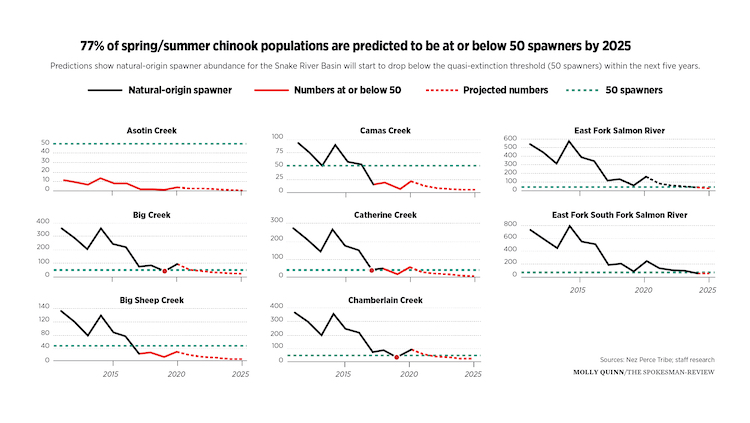forum
library
tutorial
contact

Judge Orders Stay in Case
Seeking to Remove Snake River Dams
by Nicholas Geranios, Associated Press
Daily Record, October 26, 2021
|
the film forum library tutorial contact |

|
Judge Orders Stay in Case
by Nicholas Geranios, Associated Press
|
"The next step is for us to define how to replace the services of the Snake River dams
if they are breached,"
-- Washington Gov. Jay Inslee
 SPOKANE, Wash. -- A federal judge on Tuesday granted a stay in litigation seeking to save endangered salmon runs on the Columbia and Snake rivers.
SPOKANE, Wash. -- A federal judge on Tuesday granted a stay in litigation seeking to save endangered salmon runs on the Columbia and Snake rivers.
U.S. District Judge Michael Simon in Portland, Oregon, granted a request by both sides in the lawsuit seeking the stay until July 31, 2022, so they can try to negotiate a settlement in the lawsuit.
Fishing and conservation groups joined with the state of Oregon, the Nez Perce Tribe and the Biden administration to seek the pause in litigation challenging the latest federal plan for hydropower operations on the Snake and Columbia rivers that are blamed by many for killing salmon.
The federal lawsuit, filed against the U.S. Army Corps of Engineers, Bureau of Reclamation, Bonneville Power Administration, U.S. Fish and Wildlife Service, and the National Marine Fisheries Service, involves the most recent plan for dam operations issued by the Trump administration in late 2020.
The conservation groups, along with the state of Oregon and the Nez Perce, sued to block the Trump administration plan and filed a request for an immediate injunction to dramatically increase water flow through the dams to help salmon migrate through the Snake and Columbia rivers to the ocean to mature.
The two sides last week told the judge they had reached an agreement on how eight federal dams in the Columbia River Basin will be operated over the coming year. This will include additional spill of water past the dams at certain times of year to aid fish migration, while still preserving reliable hydropower production, transportation and other services provided by the dams.
Increasing the amount of water next spring for a brief time will help juvenile salmon pass through the dams and avoid the fish-killing turbines during migration.
The Columbia River Basin was once the greatest salmon-producing river system in the world. But dams built in the basin are blamed by conservationists for pushing salmon runs toward extinction. Four dams along the Snake River in eastern Washington state -- Ice Harbor, Little Goose, Lower Monumental and Lower Granite -- slow passage along the lower Snake River, a major migration corridor linking pristine cold-water streams in central Idaho to the Pacific Ocean.
About $17 billion has been spent over two decades in efforts to prevent salmon extinction. Because of that, many groups continue to demand those four dams be breached.
Dam supporters blame declining salmon runs on other factors, such as changing ocean conditions. Opponents of breaching the dams include river users and mostly Republican politicians in the region who argue the dams provide many benefits, such as electricity, river navigation and irrigation.
In another development last Friday, Washington Gov. Jay Inslee, a Democrat, and U.S. Sen. Patty Murray, D-Washington, said they were exploring options to breach the four Snake River dams and replace the benefits they provide.
"The next step is for us to define how to replace the services of the Snake River dams if they are breached," Inslee said. "We know that they are a salmon impediment, we know that the salmon are on the verge of extinction, and we also know that they do provide services upon which a lot of folks and our economy depends."
That proposal is similar to one offered by Rep. Mike Simpson, an Idaho Republican, who in February said he could support breaching the dams and investing $33.5 billion to replace their benefits. Simpson's recommendation to breach the dams was met with fierce opposition.
"I'm not announcing a breaching decision today," Inslee said last week. "I don't want to prejudge that next step."
That wasn't good enough for Washington GOP Reps. Cathy McMorris Rodgers of Spokane; Dan Newhouse of Sunnyside; and Jaime Herrera Beutler of Battle Ground.
"It is becoming more and more clear that the public and stakeholders who rely on the Columbia Snake River System have been shut out of conversations between the Biden administration, federal agencies, and groups whose sole mission is to breach the Lower Snake River dams," the three Republicans said in a joint statement.
"We need a transparent and balanced public dialogue, not a fishy backdoor deal!" McMorris Rodgers tweeted Tuesday.
Samuel Penney, chairman of the Nez Perce Tribal Council, hailed Inslee and Murray's move.
"The Columbia Power System was literally constructed out of the rivers and reservations and homelands of 19 Columbia Basin tribes," Penney said. "When that destructive history is truly understood, the modesty of the present request is plain, and the science supporting it is clear: salmon need a free-flowing, climate-resilient Lower Snake River, not a series of slow, easily-warmed reservoirs. The Nez Perce Tribe and its people intend to ensure that salmon do not go extinct on our watch."
Kurt Miller, the executive director of Northwest RiverPartners, a hydropower advocacy group based in Vancouver, Washington, called Murray and Inslee's commitment to salmon recovery "commendable," but questioned its transparency and worried it would begin with the assumption that dam breaching is the best way to save Snake River salmon.
learn more on topics covered in the film
see the video
read the script
learn the songs
discussion forum
